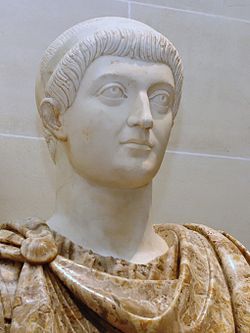|
Constans - Roman Emperor: 337-350 A.D. -
Bronze AE3 20mm (2.1 grams) Siscia mint: 334-335 A.D.
Reference: RIC 241 (VIII, Siscia), LRBC 1134
DNCONSTANSPFAVG - Diademed, draped and cuirassed bust right.
FELTEMPREPARATIO Exe: BSIS. - Phoenix standing right on pile of ashes. You are bidding on the exact item pictured,
provided with a Certificate of Authenticity and Lifetime Guarantee of
Authenticity.
The phoenix is a
mythical
sacred
firebird that originated in
Persian mythology, ancient
Phoenician
mythology (according to
Sanchuniathon),
Chinese mythology,
Egyptian religion and later
Greek mythology.
A phoenix is a mythical bird that is a fire spirit with a colorful plumage
and a tail of gold and scarlet (or purple, blue, and green according to some
legends). It has a 500 to 1,000 year life-cycle, near the end of which it builds
itself a nest of twigs that then ignites; both nest and bird burn fiercely and
are reduced to ashes, from which a new, young phoenix or phoenix egg arises,
reborn anew to live again. The new phoenix is destined to live as long as its
old self. In some stories, the new phoenix embalms the ashes of its old self in
an egg made of myrrh and deposits it in the Egyptian city of
Heliopolis (Greek
for sun-city). It is said that the bird's cry is that of a beautiful song. In
very few stories they are able to change into people.
The Roman poet Ovid
wrote the following about the phoenix:
Most beings spring from other individuals; but there is a certain kind
which reproduces itself. The Assyrians call it the Phoenix. It does not live
on fruit or flowers, but on frankincense and odoriferous gums. When it has
lived five hundred years, it builds itself a nest in the branches of an oak,
or on the top of a palm tree. In this it collects cinnamon, and spikenard,
and myrrh, and of these materials builds a pile on which it deposits itself,
and dying, breathes out its last breath amidst odors. From the body of the
parent bird, a young Phoenix issues forth, destined to live as long a life
as its predecessor. When this has grown up and gained sufficient strength,
it lifts its nest from the tree (its own cradle and its parent's sepulchre),
and carries it to the city of Heliopolis in Egypt, and deposits it in the
temple of the Sun.[1]
French author
Voltaire
thus described the phoenix:
It was of the size of an eagle, but its eyes were as mild and tender as
those of the eagle are fierce and threatening. Its beak was the color of a
rose, and seemed to resemble, in some measure, the beautiful mouth of
Formosante. Its neck resembled all the colors of the rainbow, but more
brilliant and lively. A thousand shades of gold glistened on its plumage.
Its feet seemed a mixture of purple and silver; and the tail of those
beautiful birds which were afterwards fixed to the car of Juno, did not come
near the beauty of its tail.[2]
 Flavius
Julius Constans (320-350) was a
Roman Emperor who ruled from 337 until his death. Constans was the
third and youngest son of
Constantine the Great and
Fausta,
Constantine's second wife. Flavius
Julius Constans (320-350) was a
Roman Emperor who ruled from 337 until his death. Constans was the
third and youngest son of
Constantine the Great and
Fausta,
Constantine's second wife.
On 25 December 333 Constantine elevated Constans to Caesar.
In 337 he succeeded his father, jointly with his older
brothers
Constantine II and
Constantius II, receiving
Italy,
Pannonia
and Africa as
his portion. Constantine II, who ruled over Gaul, Spain and Britain, attempted
to take advantage of his youth and inexperience by invading Italy in 340, but
Constans defeated Constantine at
Aquileia,
where the older brother died. The invasion was the effect of brotherly tensions
between the two emperors. Constantine II was, at first, Constans's guardian. As
Constans grew older, Constantine II never relinquished that position.
In 341-2, Constans led a successful campaign against the
Franks and in
the early months of 343 visited
Britain. The source for this visit,
Julius Firmicus Maternus, does not give a reason for this but the quick
movement and the danger involved in crossing the
channel in the dangerous winter months, suggests it was in response to a
military emergency of some kind, possibly to repel the
Picts and
Scots.
Regarding religion, Constans was tolerant of Judaism but
promulgated an edict banning pagan sacrifices in 341. He suppressed
Donatism in Africa and supported
Nicene orthodoxy against
Arianism,
which was championed by his brother Constantius the latter. Constans called the
Council of Sardica, which unsuccessfully tried to settle the conflict.
In 350, the general
Magnentius
declared himself emperor with the support of the troops on the
Rhine frontier,
and later the entire Western portion of the Roman Empire. Constans lacked any
support beyond his immediate household, and was forced to flee for his life.
Magnentius' supporters cornered him in a fortification in Helena, southwestern
Gaul, where he was
killed by Magnentius's assassins.
|